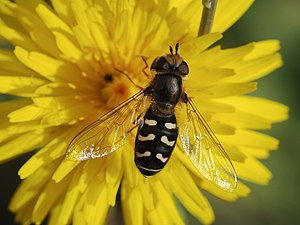Late cerebral hover fly
| Late cerebral hover fly | ||||||||||||
|---|---|---|---|---|---|---|---|---|---|---|---|---|

Late cerebral hover fly ( Scaeva pyrastri ), female |
||||||||||||
| Systematics | ||||||||||||
|
||||||||||||
| Scientific name | ||||||||||||
| Scaeva pyrastri | ||||||||||||
| ( Linnaeus , 1758) |
The late cerebral hover fly ( Scaeva pyrastri ), also called bladder-headed hover fly or half moon hover fly , is a species in the family of the hover flies (Syrphidae).
features
The flies have a body length of 10 to 15 millimeters. The vertex of the animals is black, the face gray-yellow with a brownish center line that tapers off in the middle of the face. The antennae are reddish brown. The mesonotum is glossy blue-black in color. It is dark red-brown, brownish-yellow to whitish hairy on the sides. The scutellum is brown-yellow. The legs are red-yellow, the thighs ( femora ) of the front and middle legs are colored black at the base, those of the rear legs are black at the top. The abdomen is matt black, with the tergites shining steel blue on the rear edge. There is a pair of whitish-yellow spots on each of the first three tergites. The two rear pairs of spots are curved like a crescent moon and lie obliquely, so that their front end on the inside almost borders on the front edge of the corresponding tergite. The spots in the first segment are straight. As with all species of the genus Scaeva , the forehead is very puffed up and covered with dense tufts of black hair and the compound eyes are very hairy and have significantly smaller facets on the underside than on the upper side. The face of the female is about as wide as that of the male.
The species can be confused with the early cerebral hover fly ( Scavea selenitica ), which, however, has yellow-colored spots on the abdomen.
Occurrence and habitat
The species is distributed throughout the Holarctic and occurs from North Africa and Europe, east to Japan and in North America. In Central Europe it occurs from the plains to the mountains and inhabits meadows, fields and edges of paths and forests, but also gardens. As a hiking type, it can cover long distances in flight.
Way of life
The adults fly in the lowlands from April to September, with the peak in July and August, at high altitudes in July and August. They are flower visitors and especially on umbellifers , but also on raspberries, blackberries, thistles and cypress milkweed.
As with all species of the genus Scaeva , the leech-like larvae feed on various types of aphids , which they hunt on herbaceous plants and on fruit and coniferous trees. The larvae overwinter in mud before they pupate.
supporting documents
Web links
literature
- Gerald Bothe: Hoverflies. German Youth Association for Nature Observation, Hamburg 1996.
- Joachim Haupt, Hiroko Haupt: Flies and mosquitoes: observation, way of life. Naturbuch-Verlag, Augsburg 1998, ISBN 3-89440-278-4 .
- Kurt Kormann: Hover flies and bubble-head flies of Central Europe. Fauna Verlag, Nottuln 2003, ISBN 3-935980-29-9 .

